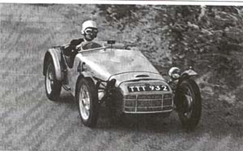
TTT 932
This story centres around the creator and managing director of SPEEDEX, Jeremy George Weston Marsh, known simply as ‘Jem’. Born in Bristol in 1930, after running away from school at 14 to join the Royal Navy for nine years, he had a variety of jobs in and around the motor industry selling tyres and agricultural equipment. Cars were his interest and an early competition outing with an Austin 7 special was in the 1954 750 Motor Club Relay race in the special TTT 932. The car was subsequently further modified and had a long competition career that is still ongoing as the Grayford Special see its own web site. Jem’s cars had many various uses, a later special ‘Marshtin’ DV 7133 being his ‘prop’ when working as a stunt driver in the ‘Hollywood Motor Maniacs and European Motor Rodeo’, an unusual name for a group from neither Europe or the USA! Jem had a stage name of Rodeo Rod.
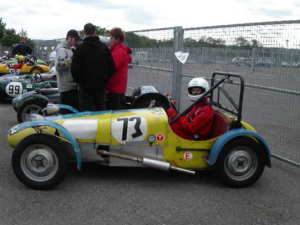

He left Firestone’s early in 1958 to join as manager of the Luton based ‘Sporting Motorists Agency’, a trade name for ‘Dante’ tuning parts for Austin 7’s. ‘Dante’ was an exotic sounding abbreviation of Dan Taylor—who made the castings! With ‘the company not in the best of health, it folded shortly afterwards, he left in April 1958 to set up his own similar company, ‘SPEEDEX Castings and Accessories Ltd’, in an old hat factory at 33 Jubilee Street of Luton.
His time at Dante obviously had familiarised him with their suppliers as his company’s products were of a similar range and bore a striking similarity to those of his former employer. The castings were made by Dan Taylor in Derbyshire, famously in ‘the privy at the bottom of the garden’ and machined in someone else’s front room. They are more likely to have come from his Horston Foundry. The first SPEEDEX advert appeared in the 750 Motor Club Bulletin May 1958.
With new affordable sports cars not easily available in the late 50’s – most British production was for exporting and the current purchase tax could be as high as a discouraging 40%; special building became the only way for young enthusiasts to economically get an interesting car to their own requirements. Austin Sevens were both readily available and easily tuned to give a respectable turn of performance. Being simple and easy to work on they formed the ideal basis for a ‘special’. As a consequence the demand for special tuning parts grew and business’s such as SPEEDEX could rapidly expand to supply it. SPEEDEX developed a range of parts along similar lines to his competitors including engine, suspension and body parts. Perhaps the most striking and innovative being 15” aluminium wheels.
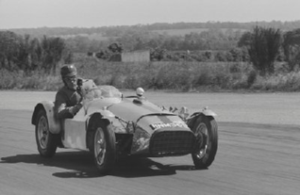
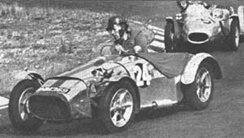
Jem was an active member of the 750 MC, he had been building his own Austin 7 special and successfully raced it in the 750 MC Formula, winning the ‘Goodacre’ Championship at the end of 1959. This low sleek special made from a frame welded from electrical conduit skinned in aluminium formed the basis of a design produced by his company – the ‘750’. Up to 200 were sold through 1959 to 1961 for £49 in both short and long wheel base forms to suit both types of donor Austin Sevens. For the 1960 racing season and onwards the ‘Jem Marsh Trophy’ was presented to the best turned out car, based on the scrutineer’s opinion, that had competed in five or more 750 Formula races encouraging quality and presentation.

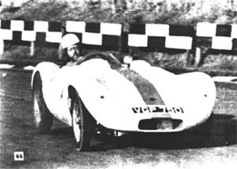
To complement his own ‘750’ model, SPEEDEX put into production as the ‘Silverstone’, the fibreglass body shell successfully developed and raced in 1959 by Mike Featherstonhaugh’s Team Sigma as the sister cars FW Special (as above) and Tony Densham’s Molina. The third car of Team Sigma was the highly successful Worden. Up to 40 ‘Silverstone’s’ were made from these moulds, perhaps some by Cambridge after the demise of Speedex, see the ‘Adverts’ page. Initial price was £70 eventually falling to £55 in an attempt to stimulate sales. With increasing demand for these goods, in 1959 more premises were found, 17a Windsor Street in Luton which after an overlap with Jubilee Street became the companies base. Another business outlet was the sale of SPEEDEX bodies and parts through other retailers around the country.
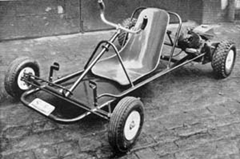
In late 1959 a ‘Spree-Kart’ go cart with a range of options and accessories was also advertised by the company. Taking a lead from the A7 wheels, cast aluminium go cart wheels were made, with wheelbarrow tyres—the only suitable size then available!
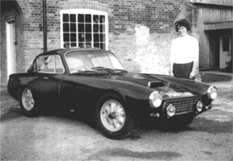
Speedex Scirocco
Diversification into Ford based specials was around the development of the ‘Sirocco’ design by Peter Hammond, a fibreglass shelled coupe on a Ford or specially designed space frame ‘Mercury’ chassis inspired by the ‘bird cage’. Initially designed with gull wing doors to compensate for high sills, later shells reverted to conventional front hinged doors. Despite the optimistic claims in the company adverts only approximately 10 of these shells were made through 1960 and ’61 at £99 each. To complement this model and to appeal to a different range of customers some special parts, notably aluminium cylinder heads were produced for the Ford based specials.
The advent of the relatively cheap and available Austin Healey Sprite and Mini along with a reduction in purchase tax in 1959 brought about a decline in special building. Advances in engine design made the A7 and Ford specials based on old side valve engines comparatively slow — plus the emergence and focus by Jem and SPEEDEX resources on the Marcos model; all of which eventually then lead to SPEEDEX folding. Adverts ceased early in 1962 and soon after, Cambridge, another of the A7 tuning companies were offering SPEEDEX wheels and the Silverstone body in their adverts.
Jem moved to work with Leslie Ballamy’s LMB company before the Marcos venture really took off. The SPEEDEX name was briefly revived by Jem in the 1980’s as a car parts supplier before being sold to a competitor.
Jem, retired from motoring and was still active as a master picture framer until his death on 2nd March 2015.
For related stories (and acknowledgement of the bits of stories I’ve ‘borrowed’) see;
- May 2003 article in Classic and Sports Car magazine
- The book ‘MARCOS, story of a Great British Sportscar’ by David Barber has a SPEEDEX chapter and other information relating to Jem’s early career before Marcos.
- The Association of Austin Seven Clubs magazine 1994D edition has a short SPEEDEX history.
- Making my Marque — a book of Jem’s own recollections from the early SPEEDEX years and through Marcos.

